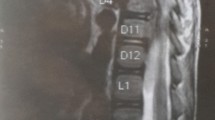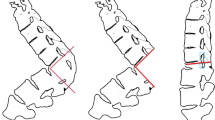Abstract
Purpose
In developing part of the world, it is common to see complete destruction of vertebral bodies in tuberculosis. Our study aims to assess the effect of spinal tuberculosis with vertebral shortening on pulmonary function.
Methods
Fifty cases of spinal TB (14 males, 36 females) managed both operatively and non-operatively, who presented to tertiary care institute between years 2011 and 2016 were assessed. Vertebral height loss was assessed by spinal deformity index (SDI). All patients underwent pulmonary function testing using same equipment sitting in upright position.
Results
Mean age was 27.9 years (27.9 ± 11.9). 11 patients with mean SDI of 2.7 ± 1.1 showed normal lung function. 36 patients showed restrictive pattern of which 12 were mild, 14 were moderate and 10 showed severe pattern with a mean SDI of 3.8 ± 1.2, 5.6 ± 1.3 and 6.1 ± 1.4, respectively. 3 cases showed obstructive pattern. As the apex of curve shifted proximally, FVC% reduced. Increase in SDI value was associated with a fall in the vital capacity and FEV1. Increase in the kyphotic angle was associated with a deleterious effect on PFT results.
Conclusions
Risk stratification of pulmonary dysfunction resulting from vertebral body height loss due to kyphosis will emphasize the need for early detection of spinal tuberculosis before deformity occurs.





Similar content being viewed by others
References
Sai Kiran NA, Vaishya S, Kale SS et al (2007) Surgical results in patients with tuberculosis of the spine and severe lower-extremity motor deficits: a retrospective study of 48 patients. J Neurosurg Spine 6:320–326
Rezai AR, Lee M, Cooper PR et al (1995) Modern management of spinal tuberculosis. Neurosurgery 36:87–97
Moorthy S, Prabhu NK (2002) Spectrum of MR imaging findings in spinal tuberculosis. AJR Am J Roentgenol 179:979–983
Genant HK, Wu CY, van Kuijk C et al (1993) Vertebral fracture assessment using a semiquantitative technique. J Bone Miner Res 8(9):1137–1148
Crans GG, Genant HK, Krege JH (2005) Prognostic utility of a semiquantitative spinal deformity index. Bone 37(2):175–179
Ansari K, Keaney N, Price M et al (2012) Precision in diagnosing and classifying COPD: comparison of historical height with current height and arm span to predict FEV(1). Open Respir Med J 6:54–58
Chhabra SK (2008) Using arm span to derive height: Impact of three estimates of height on interpretation of spirometry. Ann Thorac Med 3:94–99
Parker JM, Dillard TA, Phillips YY (1996) Arm span-height relationships in patients referred for spirometry. Am J Respir Crit Care Med 154(2 Pt 1):533–536
Alothman A, Memish ZA, Awada A et al (2001) Tuberculous spondylitis: analysis of 69 cases from Saudi Arabia. Spine (Phila Pa 1976) 26:E565–E570
Jain AK (2010) Tuberculosis of the spine: a fresh look at an old disease. J Bone Joint Surg Br 92:905–913
Kotil K, Alan MS, Bilge T (2007) Medical management of Pott disease in the thoracic and lumbar spine: a prospective clinical study. J Neurosurg Spine 6:222–228
Chadha M, Agarwal A, Singh AP (2007) Craniovertebral tuberculosis: a retrospective review of 13 cases managed conservatively. Spine (Phila Pa 1976) 32:1629–1634
Bhojraj S, Nene A (2002) Lumbar and lumbosacral tuberculous spondylodiscitis in adults. Redefining the indications for surgery. J Bone Joint Surg Br 84:530–534
Nene A, Bhojraj S (2005) Results of nonsurgical treatment of thoracic spinal tuberculosis in adults. Spine J 5:79–84
Schlaich C, Minne HW, Bruckner T et al (1998) Reduced pulmonary function in patients with spinal osteoporotic fractures. Osteoporos Int 8(3):261–267
Lombardi I Jr, Oliveira LM, Mayer AF et al (2005) Evaluation of pulmonary function and quality of life in women with osteoporosis. Osteoporos Int 16(10):1247–1253
Menon B, Aggarwal B (2007) Influence of spinal deformity on pulmonary function, arterial blood gas values, and exercise capacity in thoracic kyphoscoliosis. Neurosci (Riyadh). 12(4):293–298
Johnston CE, Richards S, Sucato DJ et al (2011) Correlation of preoperative deformity magnitude and pulmonary function tests in adolescent idiopathic scoliosis. Spine 36(14):1096–1102
Dimeglio A, Canavese F (2012) The growing spine: how spinal deformities influence normal spine and thoracic cage growth. Eur Spine J 21:64–70
Vitale MG, Matsumoto H, Bye MR et al (2008) A retrospective cohort study of pulmonary function, radiographic measures, and quality of life in children with congenital scoliosis. Spine 33(11):1242–1249
Tuli SM (1975) Results of treatment of spinal tuberculosis by “middle-path” regime. J Bone Joint Surg Br 57:13–23
Leech JA, Dulberg C, Kellie S et al (1990) Relationship of lung function to severity of osteoporosis in women. Am Rev Respir Dis 141(1):68–71
Acknowledgements
None.
Funding
No funding was received for this research.
Author information
Authors and Affiliations
Contributions
TR: conception and design of the work, acquisition, analysis, interpretation of data, drafted the work, revised it critically for important intellectual content, approved the version to be published, agreed to be accountable for all aspects of the work in ensuring that questions related to the accuracy or integrity of any part of the work are appropriately investigated and resolved. NM (corresponding author): conception and design of the work, acquisition, analysis, interpretation of data, drafted the work, revised it critically for important intellectual content, approved the version to be published, agreed to be accountable for all aspects of the work in ensuring that questions related to the accuracy or integrity of any part of the work are appropriately investigated and resolved. KM: conception and design of the work, acquisition, analysis, interpretation of data, drafted the work, revised it critically for important intellectual content, approved the version to be published, agreed to be accountable for all aspects of the work in ensuring that questions related to the accuracy or integrity of any part of the work are appropriately investigated and resolved. AJ: conception and design of the work, acquisition, analysis, interpretation of data, drafted the work, revised it critically for important intellectual content, approved the version to be published, agreed to be accountable for all aspects of the work in ensuring that questions related to the accuracy or integrity of any part of the work are appropriately investigated and resolved. SM: conception and design of the work, acquisition, analysis, interpretation of data, drafted the work, revised it critically for important intellectual content, approved the version to be published, agreed to be accountable for all aspects of the work in ensuring that questions related to the accuracy or integrity of any part of the work are appropriately investigated and resolved. ARM: conception and design of the work, acquisition, analysis, interpretation of data, drafted the work, revised it critically for important intellectual content, approved the version to be published, agreed to be accountable for all aspects of the work in ensuring that questions related to the accuracy or integrity of any part of the work are appropriately investigated and resolved. AS: conception and design of the work, acquisition, analysis, interpretation of data, drafted the work, revised it critically for important intellectual content, approved the version to be published, agreed to be accountable for all aspects of the work in ensuring that questions related to the accuracy or integrity of any part of the work are appropriately investigated and resolved.
Corresponding author
Ethics declarations
Conflict of interest
Each author certifies that he or she has no commercial associations (e.g., consultancies, stock ownership, equity interest, and patent/licensing arrangements) that might pose a conflict of interest in connection with the submitted article.
Informed consent
An Institutional Ethics Committee approval was obtained for this study and a written informed consent was taken from each participant.
Rights and permissions
About this article
Cite this article
Rathod, T.N., Marathe, N.A., Masilamani, K. et al. Are we neglecting long-term effects of vertebral shortening on pulmonary function in spinal tuberculosis?. Spine Deform 10, 169–176 (2022). https://doi.org/10.1007/s43390-021-00400-9
Received:
Accepted:
Published:
Issue Date:
DOI: https://doi.org/10.1007/s43390-021-00400-9




